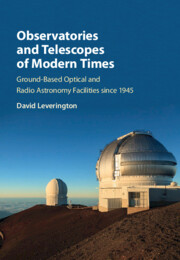 Observatories and Telescopes of Modern Times
Observatories and Telescopes of Modern Times from Part 2 - Radio Observatories
Published online by Cambridge University Press: 15 December 2016
From Radar to Radio Astronomy
Bernard Lovell had begun his investigations into cosmic rays in 1937 at the University of Manchester in the UK where P.M.S. (Patrick) Blackett was professor of physics.(1) But two years later, at the outbreak of the Second World War, Lovell was posted to an operational radar station which was assigned to track enemy aircraft. Shortly after arriving he noticed that, in addition to observing reflections from aircraft, there were numerous short-lived echoes which the radar operators attributed to the ionosphere. Lovell wondered what the cause of these signals could be, and suggested to Blackett that they may be being produced by radar reflections from the ionisation produced by highly energetic cosmic ray showers. But the exigencies of war stopped him from investigating them further.
Lovell returned to Manchester immediately the war with the intension of investigating the transient radar echoes. To do this he borrowed an army 4.2 m wavelength mobile radar with a Yagi antenna that had been used to detect V2 rockets.(2) He immediately set up the system outside the university's physics department in the middle of Manchester. There, unfortunately, any radar signals were completely overwhelmed by interference from electric trams that ran nearby. Clearly a quiet location outside the city was required. Lovell considered a number of options before settling on a plot of land at Jodrell Bank about 25 miles (40 km) south of Manchester that belonged to the university's Botanical Gardens. He was given permission to locate his equipment there for a few weeks in December 1945.
Amazingly, Lovell observed several short-lived radar echoes from various distances on his first day of observations.(3) This was repeated on the next two days but, instead of the expected one or two echoes per day, he was detecting several per hour. This led Blackett to wonder whether Lovell was really detecting echoes caused by cosmic ray ionization or whether the echoes were caused by some other effect. So he suggested that Lovell should go to see Stanley Hey, who had experience with using the V2 detection equipment during the war, as he must also have detected these short-lived signals.
To save this book to your Kindle, first ensure [email protected] is added to your Approved Personal Document E-mail List under your Personal Document Settings on the Manage Your Content and Devices page of your Amazon account. Then enter the ‘name’ part of your Kindle email address below. Find out more about saving to your Kindle.
Note you can select to save to either the @free.kindle.com or @kindle.com variations. ‘@free.kindle.com’ emails are free but can only be saved to your device when it is connected to wi-fi. ‘@kindle.com’ emails can be delivered even when you are not connected to wi-fi, but note that service fees apply.
Find out more about the Kindle Personal Document Service.
To save content items to your account, please confirm that you agree to abide by our usage policies. If this is the first time you use this feature, you will be asked to authorise Cambridge Core to connect with your account. Find out more about saving content to Dropbox.
To save content items to your account, please confirm that you agree to abide by our usage policies. If this is the first time you use this feature, you will be asked to authorise Cambridge Core to connect with your account. Find out more about saving content to Google Drive.